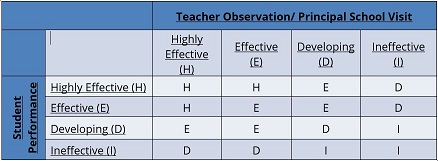Educator Evaluation Data
In 2010, New York State established a comprehensive evaluation system for teachers and principals, which was piloted by select local education agencies (LEAs) in the 2011-12 school year. In March of 2012, the New York State Education Law was revised to require all school districts to have an approved teacher and principal evaluation plan starting in the 2012-13 school year. This evaluation system, known as Annual Professional Performance Review (APPR), has been amended several times by the legislature since its inception and most recently in 2019. Although each iteration of the evaluation system has been different, an educator’s overall rating has always been based on two categories - student performance, and observations for teachers or school visits for principals.
Under Education Law 3012-d, each LEA’s evaluation plan describes how teachers and principals will be evaluated in two different categories: Student Performance and Teacher Observation/Principal School Visits. Each of these categories is comprised of two subcomponents: one required and one optional. In the Student Performance category, the required subcomponent for teachers is a student learning objective (SLO), which is a measure of student performance that is either individually attributed to the teacher being evaluated or collectively attributed to a group of teachers. For principals, the required subcomponent may be based on either an SLO or on an input model, which is a locally determined measure of the impact principal practice has on student growth. The optional subcomponent of the Student Performance category for both teachers and principals is a locally selected measure of student growth or achievement based on State-created or -administered assessments or State-designed supplemental assessments. The second category, Teacher Observation/Principal School Visits, consists of two required – principal observations/supervisor school visits and observations/school visits by an independent evaluator, and one optional –peer observations/school visits, subcomponents. For each category of a teacher’s or principal’s evaluation, a rating of Highly Effective, Effective, Developing, or Ineffective (HEDI) is assigned. The resulting ratings from each of these categories are applied to a matrix to determine an overall evaluation rating for each educator.
Evaluations completed under Education Law 3012-c, which was replaced by Education Law 3012-d in 2016, also consisted of the Student Performance and Teacher Observation/Principal School Visit categories. The Student Performance category accounted for 40% of the Overall Composite score – 20% from Student Growth on State Tests or Comparable Measures and 20% from Locally-Selected Measures of Student Learning, both of which were a required component of an educator’s evaluation. The Other Measures of Effectiveness category made up the remaining 60% of the Overall Composite score. The final Overall Composite score out of 100 was assigned an Overall Rating based on the following scale: 0-64 Ineffective, 65-74 Developing, 75-90 Effective, and 91-100 Highly Effective.






